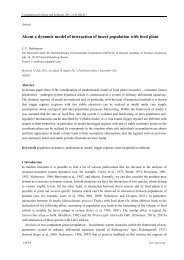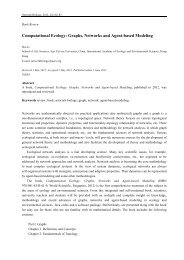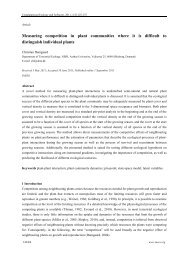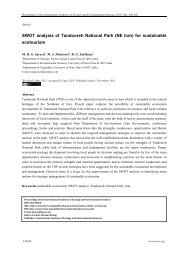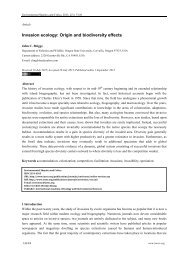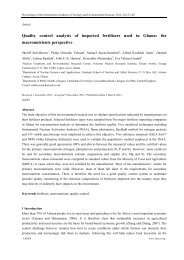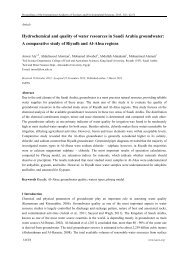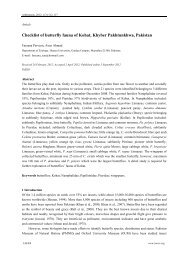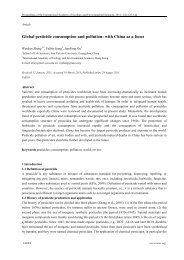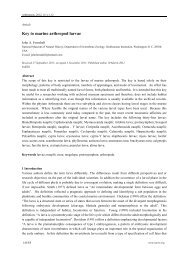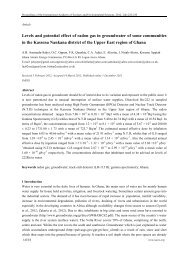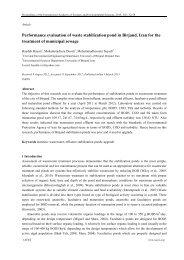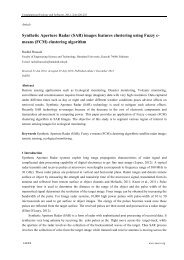Diversity and habitat preference of brachyuran crabs in Gulf of Kutch ...
Diversity and habitat preference of brachyuran crabs in Gulf of Kutch ...
Diversity and habitat preference of brachyuran crabs in Gulf of Kutch ...
Create successful ePaper yourself
Turn your PDF publications into a flip-book with our unique Google optimized e-Paper software.
Arthropods, 2012, 1(1):13-23<br />
Article<br />
<strong>Diversity</strong> <strong>and</strong> <strong>habitat</strong> <strong>preference</strong> <strong>of</strong> <strong>brachyuran</strong> <strong>crabs</strong> <strong>in</strong> <strong>Gulf</strong> <strong>of</strong> <strong>Kutch</strong>,<br />
Gujarat, India<br />
J. N. Trivedi, M. K. Gadhavi, K. D. Vachhrajani<br />
Division <strong>of</strong> Environment <strong>and</strong> Toxicology, Department <strong>of</strong> Zoology, Faculty <strong>of</strong> Science, The Maharaja Sayajirao University <strong>of</strong><br />
Baroda, Vadodara, Gujarat, India<br />
E-mail: kauresh@gmail.com<br />
Received 9 January 2012; Accepted 2 February 2012; Published onl<strong>in</strong>e 10 March 2012<br />
IAEES<br />
Abstract<br />
The biodiversity <strong>of</strong> <strong>Gulf</strong> <strong>of</strong> <strong>Kutch</strong> is studied well with special reference to scleret<strong>in</strong>ia <strong>and</strong> mollusca but the<br />
<strong>brachyuran</strong> crab taxa are rather neglected. <strong>Gulf</strong> <strong>of</strong> <strong>Kutch</strong> is very rich <strong>in</strong> floral <strong>and</strong> faunal diversity <strong>and</strong><br />
comprises different types <strong>of</strong> communities <strong>and</strong> <strong>habitat</strong>s like very unique coral reefs, mangroves, s<strong>and</strong>y shores,<br />
rocky shores <strong>and</strong> mudflats. Brachyuran <strong>crabs</strong> are the most diverse group among mar<strong>in</strong>e fauna hav<strong>in</strong>g 5000<br />
species world wide. Some studies on the <strong>in</strong>tertidal fauna, <strong>in</strong>clud<strong>in</strong>g <strong>brachyuran</strong> <strong>crabs</strong>, have been carried out <strong>in</strong><br />
<strong>Gulf</strong> <strong>of</strong> <strong>Kutch</strong> but the f<strong>in</strong>d<strong>in</strong>gs were not sufficient to draw out taxonomic diversity. Present work on <strong>Gulf</strong> <strong>of</strong><br />
<strong>Kutch</strong> is an <strong>in</strong>itiative to scan the entire coastal Gujarat <strong>and</strong> establish directory <strong>of</strong> <strong>brachyuran</strong> crab diversity.<br />
S<strong>in</strong>ce the <strong>Gulf</strong> <strong>habitat</strong> is diverse <strong>and</strong> dist<strong>in</strong>ct, eight different stations (16 sample sites) were sampled. The<br />
selection <strong>of</strong> the sample site was done on the basis <strong>of</strong> <strong>habitat</strong> type which <strong>in</strong>cluded mangrove mudflats, open<br />
mudflats <strong>and</strong> rocky shores. A total <strong>of</strong> 19 species belong<strong>in</strong>g to 8 families <strong>and</strong> 15 genera were recorded. Open<br />
mud flats were most preferred by the <strong>crabs</strong> followed by the mangrove mud flats <strong>and</strong> rocky shore.<br />
Keywords <strong>brachyuran</strong> <strong>crabs</strong>; <strong>Gulf</strong> <strong>of</strong> <strong>Kutch</strong>; mangrove; mudflat; <strong>habitat</strong> <strong>preference</strong>.<br />
1 Introduction<br />
Studies on the local checklist <strong>of</strong> fauna are <strong>of</strong> great importance for the formulation <strong>of</strong> conservation polices<br />
(Fransozo et al., 1992; Hebl<strong>in</strong>g et al., 1994), because these studies lead to the best underst<strong>and</strong><strong>in</strong>g <strong>of</strong> community<br />
structure, ecological processes <strong>and</strong> problem faced by ecosystem. The coastal or mar<strong>in</strong>e environs comprise<br />
some <strong>of</strong> the high biodiversity areas (Khan et al., 2005). The environs conta<strong>in</strong> specialized <strong>habitat</strong>s like salt<br />
marshes, coral reefs <strong>and</strong> mangroves <strong>and</strong> each <strong>habitat</strong> has their specific animal community. Crustaceans are the<br />
most crucial groups <strong>of</strong> tropical benthic communities. The larger <strong>and</strong> more abundant species are important for<br />
human consumption while the <strong>in</strong>credible variety <strong>of</strong> small species contribute importantly to the complexity <strong>and</strong><br />
function<strong>in</strong>g <strong>of</strong> tropical ecosystems (Hendrickx, 1995); for e. g. on rocky shores, <strong>crabs</strong> are prime predators on<br />
molluscs, small crustaceans <strong>and</strong> other <strong>in</strong>vertebrates, but on the other side they also provide prey base for fish,<br />
decapods <strong>and</strong> some terrestrial vertebrates (Siddon <strong>and</strong> Witman, 2004). So as a prey <strong>and</strong> predator they have<br />
potential <strong>in</strong>fluence on the behaviour, distribution <strong>and</strong> abundance <strong>of</strong> their own as well as neighbor<strong>in</strong>g<br />
communities (Seeley, 1986; Trussell <strong>and</strong> Nickl<strong>in</strong>, 2002). Among all benthic macro fauna which dwells <strong>in</strong> the<br />
<strong>in</strong>tertidal zone, <strong>brachyuran</strong>s are the most prom<strong>in</strong>ent because <strong>of</strong> great diversity, compris<strong>in</strong>g <strong>of</strong> about 700 genera<br />
<strong>and</strong> 5000 species (Melo, 1996). Brachyurans are most important group for mangrove ecosystem because they<br />
IAEES<br />
www.iaees.org
14<br />
Arthropods, 2012, 1(1):13-23<br />
make 80% faunal biomass (Golly et al., 1962) <strong>and</strong> their density can reach up to 80-90 <strong>in</strong>dividuals per m 2<br />
(Mac<strong>in</strong>tosh, 1984).<br />
<strong>Gulf</strong> <strong>of</strong> <strong>Kutch</strong>, an <strong>in</strong>dent to ma<strong>in</strong>l<strong>and</strong> <strong>of</strong> Gujarat is fourth major coral reefs areas <strong>of</strong> India. This area is<br />
geographically isolated from other reef areas <strong>of</strong> India; still it shows great varieties <strong>of</strong> mar<strong>in</strong>e <strong>habitat</strong>s like coral<br />
reefs, mangroves, rocky <strong>in</strong>tertidal zone <strong>and</strong> sea grass beds. The area is extensively explored by researchers as<br />
far as Scleracitnian <strong>and</strong> molluscs groups are concerned. Total 45 different species <strong>of</strong> hard corals (Dixit et al.,<br />
2010; Pillai <strong>and</strong> Patel, 1988) <strong>and</strong> 188 species <strong>of</strong> mollusc species were recorded <strong>in</strong> this area (Apte, 1998). Major<br />
mangrove forest cover <strong>of</strong> the state lies <strong>in</strong> the area <strong>and</strong> the mangrove ecology is well studied with reference to<br />
floral diversity but faunal component is least studied (P<strong>and</strong>ey <strong>and</strong> P<strong>and</strong>ey, 2010). Except few studies on<br />
mar<strong>in</strong>e fauna <strong>of</strong> the then Mumbai state (Chhapgar, 1957) no particular studies on <strong>brachyuran</strong> crab fauna have<br />
been done. So to generate the basel<strong>in</strong>e picture <strong>of</strong> <strong>brachyuran</strong> crab diversity <strong>of</strong> <strong>Gulf</strong> <strong>of</strong> <strong>Kutch</strong>, the present study<br />
was carried out at eight different sites <strong>of</strong> <strong>Gulf</strong> <strong>of</strong> <strong>Kutch</strong>. The ma<strong>in</strong> aim <strong>of</strong> the study is to generate the<br />
<strong>in</strong>formation on <strong>brachyuran</strong> crab diversity <strong>and</strong> their <strong>habitat</strong> <strong>preference</strong> <strong>in</strong> selected <strong>habitat</strong>s <strong>of</strong> <strong>Gulf</strong> <strong>of</strong> <strong>Kutch</strong>.<br />
However, the area <strong>of</strong> Mar<strong>in</strong>e National Park <strong>and</strong> Sanctuary was not <strong>in</strong>cluded <strong>in</strong> the present study.<br />
2 Materials <strong>and</strong> Methods<br />
2.1 Study sites<br />
<strong>Gulf</strong> <strong>of</strong> <strong>Kutch</strong> is the western proximity <strong>of</strong> Gujarat state <strong>and</strong> as stated earlier, it harbors huge variety <strong>of</strong> mar<strong>in</strong>e<br />
fauna. For the present study few locations <strong>of</strong> <strong>Gulf</strong> <strong>of</strong> <strong>Kutch</strong> (except Mar<strong>in</strong>e National Park <strong>and</strong> Sanctuary area)<br />
were selected (Fig. 1). The study sites were not with<strong>in</strong> the Mar<strong>in</strong>e national Park, however, consider<strong>in</strong>g the<br />
legislative regulations collection, preservation or museum deposition <strong>of</strong> any specimen was not done.<br />
1<br />
2<br />
3<br />
4<br />
5<br />
6<br />
16<br />
15<br />
14<br />
13<br />
8<br />
10<br />
9<br />
12 11<br />
7<br />
Fig. 1 Distribution <strong>of</strong> sampl<strong>in</strong>g sites <strong>in</strong> study area<br />
The crab diversity was studied at eight different stations (Table 1). Selection <strong>of</strong> the stations was done on<br />
the basis <strong>of</strong> two parameters; one is <strong>habitat</strong> diversity (e.g. mangroves mudflats, open mudflats <strong>and</strong> rocky shores)<br />
<strong>and</strong> second is accessibility <strong>of</strong> the study site. The study area was classified <strong>in</strong> to three ma<strong>in</strong> <strong>habitat</strong> types; among<br />
the mud flats; area near the low tide mark <strong>and</strong> with no vegetation cover was considered as open mudflat, the<br />
mud flat which has mangrove canopy cover is considered as mangrove mudflats <strong>and</strong> the others <strong>in</strong>cluded rocky<br />
shores. Avic<strong>in</strong>ia mar<strong>in</strong>a makes the major canopy cover <strong>of</strong> mangrove mudflats <strong>of</strong> the study area while the<br />
canopy made by Rhizophora mucronata <strong>and</strong> Ceriops tugal were comparatively much sparse. Furthermore, the<br />
IAEES<br />
www.iaees.org
Arthropods, 2012, 1(1):13-23<br />
15<br />
detail pr<strong>of</strong>ile <strong>of</strong> different mar<strong>in</strong>e <strong>habitat</strong>s <strong>and</strong> their coverage area <strong>in</strong> each station was prepared. For detail study<br />
<strong>of</strong> <strong>brachyuran</strong> crab diversity <strong>and</strong> their <strong>habitat</strong> <strong>preference</strong>, each station was divided <strong>in</strong>to two different sampl<strong>in</strong>g<br />
sites. Two different <strong>habitat</strong>s which had maximum coverage area were surveyed as sampl<strong>in</strong>g site <strong>in</strong> each station<br />
(Table 1). Total 16 sampl<strong>in</strong>g sites were surveyed <strong>of</strong> which total 8, 6 <strong>and</strong> 2 sites were surveyed for mangrove<br />
mudflat, open mudflat <strong>and</strong> rocky shore, respectively.<br />
Table 1 Study sites<br />
Station Sampl<strong>in</strong>g Site description<br />
site<br />
Nalia 1 Mangrove mudflat<br />
2 Open mudflat<br />
Mundra 3 Open mudflat<br />
4 Mangrove mudflat<br />
Jodia 5 Mangrove mudflat<br />
6 Open mudflat<br />
Jamnagar 7 Mangrove mudflat<br />
8 Open mudflat<br />
Sikka 9 Rocky<br />
10 Mangrove mudflat<br />
Khambhalia 11 Mangrove mudflat<br />
12 Open mudflat<br />
Bhatia 13 Mangrove mudflat<br />
14 Open mudflat<br />
Poshitra 15 Mangrove mudflat<br />
16 Rocky<br />
2.2 Sampl<strong>in</strong>g methods<br />
Belt transect method was adopted for the study. Two belt transects (10x50m) were laid <strong>in</strong> each sampl<strong>in</strong>g site<br />
<strong>and</strong> whatever species encountered dur<strong>in</strong>g the survey was collected. For the collection <strong>of</strong> w<strong>and</strong>er<strong>in</strong>g <strong>crabs</strong><br />
h<strong>and</strong>pick<strong>in</strong>g method was used <strong>and</strong> for burrow<strong>in</strong>g crab patient wait for the crab to come out <strong>of</strong> the burrow was<br />
the only option so as not to harm the crab while collection. The collected specimens were immediately<br />
photographed, sketched for noteworthy characters <strong>and</strong> identified tentatively <strong>in</strong> the field. After identification, all<br />
the specimens were released unharmed <strong>in</strong> their particular <strong>habitat</strong>. The identification was confirmed based on<br />
photographs, draw<strong>in</strong>gs <strong>and</strong> character description <strong>and</strong> compar<strong>in</strong>g them with the illustrative keys<br />
(Sethuramal<strong>in</strong>gam <strong>and</strong> Ajmal Khan, 1991, Jeyabaskaran, et al., 2000). For further conformation <strong>of</strong> species, all<br />
the details <strong>of</strong> the specimens were compared with the <strong>in</strong>formation available on Mar<strong>in</strong>e Species Identification<br />
Portal website (www.species-identification.org.com) <strong>and</strong> National Institute <strong>of</strong> Oceanography web site on<br />
Mar<strong>in</strong>e Fauna Information (Jeyabaskaran et al., 2002). The classification <strong>of</strong> <strong>brachyuran</strong> <strong>crabs</strong> was adopted<br />
from WORMS website (www.mar<strong>in</strong>especies.org). Bray – Curtis similarity percentage was calculated for each<br />
site <strong>and</strong> a dendrogram was drawn for group<strong>in</strong>g <strong>of</strong> similar sites.<br />
3 Results<br />
Total 19 species <strong>of</strong> <strong>brachyuran</strong> <strong>crabs</strong> belong<strong>in</strong>g to 8 families <strong>and</strong> 15 genera were recorded from the study area<br />
where family Ocypodidae, Grapsidae <strong>and</strong> Portunidae contribute 4 species each (Fig. 2). Three species were<br />
belong<strong>in</strong>g to family Xanthidae while rest <strong>of</strong> the families <strong>in</strong>clud<strong>in</strong>g Pilumnidae, Gecarc<strong>in</strong>idae, Goneplacidae,<br />
<strong>and</strong> Eriphiidae contributed only one species each. Uca lactea annulipes, Parasesarma plictum, Scylla serrata<br />
<strong>and</strong> Cardisoma cranifex were most dom<strong>in</strong>ant <strong>brachyuran</strong> crab species recorded from 13, 12, 11 <strong>and</strong> 9 different<br />
IAEES<br />
www.iaees.org
16<br />
Arthropods, 2012, 1(1):13-23<br />
sampl<strong>in</strong>g sites, respectively. Five species <strong>of</strong> <strong>crabs</strong> <strong>in</strong>clud<strong>in</strong>g Charybdis acutifrons, Charybdis feriatus,<br />
Ocypode ceratopthelma, Atergatis <strong>in</strong>tegerrimus, <strong>and</strong> Atergatis subdentatus were encountered only <strong>in</strong> one study<br />
site each. The maximum number <strong>of</strong> <strong>brachyuran</strong> crab species were recorded from Poshitra (11 species)<br />
followed by Mundra (9 species), Naliya (8 species) <strong>and</strong> Khambhaliya (8 species). Bhatia, Jodia <strong>and</strong> Sikka<br />
contributed same number <strong>of</strong> species (7 species) while m<strong>in</strong>imum species diversity was recorded from Jamnagar<br />
(4 species). In sampl<strong>in</strong>g sites diversity, maximum diversity <strong>of</strong> <strong>brachyuran</strong> <strong>crabs</strong> was recorded from site number<br />
2 while m<strong>in</strong>imum diversity was recorded from site number 7 (Table 2, Figs 3 <strong>and</strong> 4).<br />
As stated earlier, the whole study area is divided <strong>in</strong>to three different <strong>habitat</strong>s <strong>in</strong>clud<strong>in</strong>g mangrove mudflat,<br />
open mudflat <strong>and</strong> rocky shore, where the area <strong>of</strong> rocky shore was very small as compared to others so only two<br />
sampl<strong>in</strong>g sites were surveyed for rocky shore crab diversity. The <strong>habitat</strong> <strong>preference</strong> <strong>of</strong> <strong>brachyuran</strong> crab was<br />
studied <strong>in</strong> these three <strong>habitat</strong>s <strong>and</strong> maximum number <strong>of</strong> species was recorded from open mudflats followed by<br />
mangrove mudflats <strong>and</strong> rocky shore. Though the area <strong>of</strong> rocky shore was small still it supports comparatively<br />
good diversity.<br />
Total 10 species belong<strong>in</strong>g to 5 families <strong>and</strong> 8 genera were recorded from mangrove mudflat <strong>habitat</strong><br />
(Tables 2, 3). The number <strong>of</strong> species recorded for family Grapsidae which is typically found <strong>in</strong> mangrove<br />
environment was three. Family Portunidae contributed three species <strong>in</strong> the species account followed by<br />
Ocypodidae (2 species), Gecarc<strong>in</strong>idae (1 species) <strong>and</strong> Goneplacidae (1 species). Uca lactea annulipes <strong>and</strong><br />
Parasesarma plictum were recorded <strong>in</strong> seven different sites out <strong>of</strong> eight sites surveyed which makes them<br />
dom<strong>in</strong>ant species <strong>of</strong> the <strong>habitat</strong>. Other common <strong>brachyuran</strong> crab species <strong>of</strong> mangrove mudflat <strong>habitat</strong> recorded<br />
were Scylla serrata (5 sites) <strong>and</strong> Cardisoma carnifex (5 sites). Though family Grapsidae is very common <strong>in</strong><br />
mangrove <strong>habitat</strong> still except Parasesarma plictum other species like Grapsus <strong>in</strong>termedius <strong>and</strong> Grapsus<br />
albol<strong>in</strong>eatus were recorded from two <strong>and</strong> three different sites only, respectively. Neoepisesarma tetragonum<br />
belong<strong>in</strong>g to family grapsidae was not recorded from mangrove mudflat.<br />
0.96<br />
0.9<br />
6 7 2 3 1 4 5 8<br />
Similarity<br />
0.84<br />
0.78<br />
0.72<br />
066<br />
0.6<br />
0.54<br />
0.48<br />
0.42<br />
0 1 2 3 4 5 6 7 8 9<br />
Fig. 2 Dendrogram <strong>of</strong> <strong>brachyuran</strong> crab diversity recorded from different station <strong>of</strong> <strong>Gulf</strong> <strong>of</strong> <strong>Kutch</strong>.<br />
In open mudflat <strong>habitat</strong> total 11 species belong<strong>in</strong>g to 6 families <strong>and</strong> 10 genera were recorded (Tables 2, 3).<br />
Scylla serrata <strong>and</strong> Uca lactea annulipes were the dom<strong>in</strong>ant species as they were found <strong>in</strong> all the sampl<strong>in</strong>g sites<br />
<strong>of</strong> open mudflat <strong>habitat</strong> while the other common species like Macropthelmus pect<strong>in</strong>ipes, Grapsus <strong>in</strong>termedius,<br />
Parasesarma plictum, Neopisesarma tetragonum, Cardisoma carnifex were also recorded from the <strong>habitat</strong>.<br />
IAEES<br />
www.iaees.org
Arthropods, 2012, 1(1):13-23<br />
17<br />
Becides Uca lactea annulipes, another species Uca dussumieri belong<strong>in</strong>g to family ocypodidae which mostly<br />
prefer muddy <strong>habitat</strong> was also recorded. Some species like Portunus pelagicus, Grapsus albol<strong>in</strong>eatus <strong>and</strong><br />
Goneplex rhomboids were recorded once <strong>in</strong> the <strong>habitat</strong>. Family Ocypodidae <strong>and</strong> Grapsidae were the most<br />
dom<strong>in</strong>ant families contribut<strong>in</strong>g 4 species each to the species account. Family Portunidae was contribut<strong>in</strong>g two<br />
species while family Gecarc<strong>in</strong>idae, Pilumnidae <strong>and</strong> Goneplacidae were contribut<strong>in</strong>g one species each to the<br />
species account. Among the 7 sites surveyed for open mudflat <strong>habitat</strong> site no 2 was hav<strong>in</strong>g maximum diversity<br />
<strong>of</strong> <strong>brachyuran</strong> <strong>crabs</strong> (8 species) while site no 8 was hav<strong>in</strong>g m<strong>in</strong>imum diversity (4 species). Other sites were<br />
similar to each other <strong>in</strong> terms <strong>of</strong> <strong>brachyuran</strong> crab diversity.<br />
Species <strong>and</strong> Family<br />
Table 2 <strong>Diversity</strong> <strong>of</strong> <strong>brachyuran</strong> <strong>crabs</strong> at different stations <strong>of</strong> <strong>Gulf</strong> <strong>of</strong> <strong>Kutch</strong> (Fig. 3, 4)<br />
Nalia<br />
Mund<br />
ra<br />
Jodia<br />
Jamn<br />
agar<br />
Stations <strong>and</strong> sampl<strong>in</strong>g sites<br />
Sikka Khambhal Bhatia Poshitra TR<br />
ia<br />
1 2 3 4 5 6 7 8 9 10 11 12 13 14 15 16<br />
Portunidae<br />
Scylla serrata X X X X X X X X X X X 11<br />
Charybdis acutifrons X X 1<br />
Charybdis feriatus X 1<br />
Portunus pelagicus X X X 3<br />
Ocypodidae<br />
Uca lactea annulipes X X X X X X X X X X X X X 13<br />
Uca dussumieri X X X X 4<br />
Ocypode ceratopthelma X 1<br />
Macropthelmus pect<strong>in</strong>ipes X X X X 4<br />
Grapsidae<br />
Grapsus <strong>in</strong>termedius X X X X X X 6<br />
Grapsus albol<strong>in</strong>eatus X X X X X 5<br />
Parasesarma plictum X X X X X X X X X X X X 12<br />
Neopisesarma tetragonum X X X X 4<br />
Xanthidae<br />
Atergatis <strong>in</strong>tegerrimus X 1<br />
Atergatis subdentatus X 1<br />
Platypodia cristata X X 2<br />
Pilumnidae<br />
Pilumnus vesperitilio X X 2<br />
Gecarc<strong>in</strong>idae<br />
Cardisoma carnifex X X X X X X X X X 9<br />
Eriphiidae<br />
Menippe rumphii X X 2<br />
Goneplacidae<br />
Goneplex rhomboides X X 2<br />
Total species (Sample<br />
site) 6 8 7 4 5 7 2 4 4 4 4 6 5 7 7 4<br />
Total species (Station) 8 9 7 4 7 8 7 11<br />
IAEES<br />
www.iaees.org
18<br />
Arthropods, 2012, 1(1):13-23<br />
Fig. 3 (a) Scylla serrata Forskal, 1755; (b) Charybdis feriatus de Man, 1879; (c) Uca lactea annulipes H. Milne Edward, 1837;<br />
(d) Charybdis acutifrons de Man, 1879; (e) Uca dussumieri H. Milne Edward, 1852; (f) Ocypode ceratopthelma Pallas, 1872; (g)<br />
Atergatis <strong>in</strong>tegerrimus Lamarck, 1801; (h) Cardisoma carnifex Herbst, 1796; (i) Parasesarma plictum Latrille, 1803; (j)<br />
Mennipe rumphi Fabricius, 1798; (k) Platypodia cristata A. Milne Edward, 1837; (l) Pilumnus vespertilio Fabricius, 1793<br />
IAEES<br />
www.iaees.org
Arthropods, 2012, 1(1):13-23<br />
19<br />
Fig. 4 (a) Goneplex rhomboides L<strong>in</strong>naeus, 1758; (b) Neopisesarma tetragonum de Man, 1887; (c) Grapsus <strong>in</strong>termidius de Man,<br />
1888 ; (d) Grapsus albioneatus Lamarck, 1818 (e) Atergatis subdentatus de Haan, 1835; (f) Portunus pelagicus L<strong>in</strong>naeus, 1758;<br />
(g) Macropthelmus pect<strong>in</strong>ipes Guer<strong>in</strong>, 1839<br />
In the case <strong>of</strong> rocky shore <strong>habitat</strong> only two sampl<strong>in</strong>g sites were surveyed <strong>and</strong> total 7 species belong<strong>in</strong>g to 5<br />
families <strong>and</strong> 7 genera were recorded (Tables 2, 3). Family Xanthidae was dom<strong>in</strong>ant family on rocky shore<br />
which contributed three species followed by Eriphiidae, Pilumnidae, Grapsidae <strong>and</strong> Portunidae which<br />
contributed one species each to the species account. Genus Atergatis was dom<strong>in</strong>ant at both the sites. Species<br />
like Atergatis <strong>in</strong>tegerrimus, Atergatis subdentatus, Platypodia cristata, Pilumnus vesperitilio <strong>and</strong> Menippe<br />
rumphii were recorded only from rocky shore <strong>habitat</strong>. The sampl<strong>in</strong>g site no. 16 which falls <strong>in</strong> Poshitra study<br />
station was more diverse than sampl<strong>in</strong>g site no. 9 <strong>of</strong> Sikka (Table 3).<br />
IAEES<br />
www.iaees.org
20<br />
Arthropods, 2012, 1(1):13-23<br />
Table 3 Habitat <strong>preference</strong> <strong>of</strong> <strong>brachyuran</strong> crab species<br />
Habitat type<br />
Species<br />
Mangrove mudflat<br />
Open mudflat<br />
Rocky<br />
shore<br />
Sampl<strong>in</strong>g sites<br />
1 4 5 7 10 11 13 16 2 3 6 8 12 14 9 15<br />
Scylla serrata X X X X X X X X X X X<br />
Charybdis acutifrons<br />
X<br />
Charybdis feriatus<br />
X<br />
Portunus pelagicus X X X<br />
Uca lactea annulipes X X X X X X X X X X X X X<br />
Uca dussumieri X X X X<br />
Ocypode ceratopthelma<br />
X<br />
Macropthelmus pect<strong>in</strong>ipes X X X X<br />
Grapsus <strong>in</strong>termedius X X X X X X<br />
Grapsus albol<strong>in</strong>eatus X X X X X<br />
Parasesarma plictum X X X X X X X X X X X X<br />
Neopisesarma tetragonum X X X X<br />
Atergatis <strong>in</strong>tegerrimus<br />
X<br />
Atergatis subdentatus<br />
X<br />
Platypodia cristata X X<br />
Pilumnus vesperitilio X X<br />
Cardisoma carnifex X X X X X X X X X<br />
Menippe rumphii X X<br />
Goneplex rhomboids X X<br />
Total species (Sample site) 6 4 5 2 4 4 5 4 8 7 7 4 6 7 4 7<br />
Total species (Habitat) 10 11 7<br />
Table 4 Bray-Curtis similarity for <strong>brachyuran</strong> <strong>crabs</strong> collected from different stations<br />
Station Name Nalia Mundra Jodia Jamnagar Sikka Khambhalia Bhatia Dwarka<br />
Nalia 0.0 0.0 0.0 0.0 0.0 0.0 0.0 0.0<br />
Mundra 85.7 0.0 0.0 0.0 0.0 0.0 0.0 0.0<br />
Jodia 86.7 92.9 0.0 0.0 0.0 0.0 0.0 0.0<br />
Jamnagar 56.0 69.6 72.0 0.0 0.0 0.0 0.0 0.0<br />
Sikka 35.7 46.2 50.0 52.2 0.0 0.0 0.0 0.0<br />
Khambhalia 78.8 83.9 90.9 71.4 58.1 0.0 0.0 0.0<br />
Bhatia 76.5 81.3 88.2 69.0 56.3 97.3 0.0 0.0<br />
Dwarka 29.4 37.5 41.2 41.4 81.3 54.1 57.9 0.0<br />
The similarity <strong>in</strong> species diversity <strong>and</strong> composition between different sites was rang<strong>in</strong>g from 29.4% to<br />
97.3% (Table 4) with an average similarity percentage <strong>of</strong> 64.1. For further analysis <strong>of</strong> site similarity, the<br />
dendrogram was drawn <strong>and</strong> it revealed separate group<strong>in</strong>g <strong>of</strong> similar stations. Stations 6 <strong>and</strong> 7 formed a group<br />
with maximum similarity percentage <strong>of</strong> 97.3. Stations 2 <strong>and</strong> 3 formed a group with similarity percentage <strong>of</strong><br />
92.9 to which station 1 has got l<strong>in</strong>ked at 85.7%. Stations 1, 2 <strong>and</strong> 3 which represent mangrove mudflat <strong>and</strong><br />
IAEES<br />
www.iaees.org
Arthropods, 2012, 1(1):13-23<br />
21<br />
open mudflat areas have got similar k<strong>in</strong>d <strong>of</strong> diversity <strong>and</strong> this group got l<strong>in</strong>ked with the group <strong>of</strong> stations 6 <strong>and</strong><br />
7 at 83.9%. Station 4 which also represent mangrove mudflat, but has less diversity, got l<strong>in</strong>ked with ma<strong>in</strong><br />
group with similarity percentage <strong>of</strong> 69.0. Stations 5 <strong>and</strong> 8 which represent rocky shore <strong>habitat</strong> formed a<br />
separate group with similarity percentage <strong>of</strong> 81.3. The major two groups <strong>in</strong>clud<strong>in</strong>g rocky shore as one <strong>and</strong> the<br />
second <strong>in</strong>clud<strong>in</strong>g both the mangrove <strong>and</strong> open mudflat <strong>habitat</strong> l<strong>in</strong>ked with each other with the similarity<br />
percentage <strong>of</strong> 46.2 only.<br />
4 Discussion<br />
Monitor<strong>in</strong>g <strong>and</strong> basel<strong>in</strong>e surveys are <strong>of</strong> great importance to know the present status <strong>of</strong> native <strong>and</strong> <strong>in</strong>vad<strong>in</strong>g<br />
species (Melo, 1996). Along the sea coast <strong>of</strong> <strong>Gulf</strong> <strong>of</strong> <strong>Kutch</strong> base l<strong>in</strong>e surveys for species diversity <strong>of</strong> coral <strong>and</strong><br />
mollusca are recorded but the studies on <strong>brachyuran</strong> <strong>crabs</strong> are sparse <strong>and</strong> non def<strong>in</strong>itive (Dixit et al., 2010 ). In<br />
the present study we recorded 19 species <strong>of</strong> <strong>brachyuran</strong> <strong>crabs</strong> from selected areas <strong>of</strong> <strong>Gulf</strong> <strong>of</strong> <strong>Kutch</strong>. By<br />
compar<strong>in</strong>g different k<strong>in</strong>ds <strong>of</strong> <strong>habitat</strong>s like open mudfalts, mangrove mudflats <strong>and</strong> rocky shore, one can<br />
postulate the species dom<strong>in</strong>ancy on the <strong>habitat</strong>. Maximum diversity <strong>of</strong> <strong>brachyuran</strong> crab was recorded from<br />
open mudflat followed by mangrove mudflat <strong>and</strong> rocky shore. Open mudflats provide unique k<strong>in</strong>d <strong>of</strong> <strong>habitat</strong> to<br />
several species <strong>of</strong> <strong>brachyuran</strong> <strong>crabs</strong>. 11 species <strong>of</strong> <strong>brachyuran</strong> <strong>crabs</strong> have been recorded from open mudflat <strong>of</strong><br />
Mahi river estuary (P<strong>and</strong>ya, 2011). Open mudflat <strong>habitat</strong> is a dom<strong>in</strong>ant <strong>habitat</strong> type <strong>in</strong> Mahi estuary <strong>and</strong><br />
species like Uca lactea annulipes, Macropthelmus depressus, M.dilatatus were dom<strong>in</strong>ant. Here, <strong>in</strong> <strong>Gulf</strong> <strong>of</strong><br />
<strong>Kutch</strong>, Uca lactea annulipes, Scylla serrata <strong>and</strong> Parasesarma plictum were dom<strong>in</strong>ant species while the density<br />
<strong>of</strong> Macropthelmus pect<strong>in</strong>ipes was also good.<br />
Mangroves provide extra ord<strong>in</strong>ary <strong>habitat</strong> for <strong>brachyuran</strong> <strong>crabs</strong> as well as for other benthic fauna. However,<br />
the diversity was comparatively less than the open mud flat <strong>habitat</strong>s. Few families like Sesarmidae, Grapsidae,<br />
Ocypodidae <strong>and</strong> Xanthidae make most <strong>of</strong> the <strong>brachyuran</strong> crab diversity <strong>of</strong> mangroves. Among the entire<br />
benthic fauna that dwells <strong>in</strong> mangroves, grapsid <strong>crabs</strong> are most important <strong>in</strong> terms <strong>of</strong> species diversity <strong>and</strong><br />
density (Daudouh – Guebas, et al., 1997). In the present study we recorded 10 species <strong>of</strong> <strong>brachyuran</strong> <strong>crabs</strong> <strong>in</strong><br />
mangrove mudflats. Family Grapsidae <strong>and</strong> Portunidae were dom<strong>in</strong>ant <strong>in</strong> mangrove mud flats contribut<strong>in</strong>g three<br />
species each. U. lactea annlipes <strong>and</strong> P. plictum were recorded from all the stations surveyed. Khan et al. (2005)<br />
has recorded 38 species <strong>of</strong> <strong>brachyuran</strong> <strong>crabs</strong> from Pichavaram mangroves amongst them 18 species belonged<br />
to family Grapsidae while 8 to the family Ocypodidae. Davie (1982) has recorded 32 species <strong>of</strong> <strong>brachyuran</strong><br />
<strong>crabs</strong> from mangroves <strong>of</strong> Hong Kong <strong>and</strong> Australia while Tan <strong>and</strong> Ng (1994) found 51 species <strong>of</strong> Grapsids<br />
from mangroves <strong>of</strong> Pen<strong>in</strong>sular Malasia. All above records show higher diversity <strong>of</strong> <strong>crabs</strong> as compared to the<br />
present study. Crabs play important ecological role <strong>in</strong> mangrove forest. They decompose the leaf litter <strong>and</strong><br />
<strong>in</strong>crease the availability <strong>of</strong> nutrient for other fauna <strong>and</strong> flora. Crabs always change the substratum pr<strong>of</strong>ile as<br />
bioturburator which drives the nutrient cycl<strong>in</strong>g <strong>in</strong> mudflats <strong>and</strong> mangroves (P<strong>and</strong>ya <strong>and</strong> Vachhrajani, 2010,<br />
2011). The species diversity <strong>of</strong> <strong>brachyuran</strong> <strong>crabs</strong> <strong>in</strong> mangroves depends on the density <strong>and</strong> species diversity <strong>of</strong><br />
the mangroves <strong>and</strong> prevail<strong>in</strong>g hydro biological conditions (Davie, 1982).<br />
Rocky shores are amongst the most dynamic <strong>habitat</strong>s found along the sea coast <strong>of</strong> the world. Many factors<br />
play important role <strong>in</strong> determ<strong>in</strong><strong>in</strong>g the nature <strong>of</strong> rocky shore communities. Abiotic factors like wave action,<br />
slope <strong>and</strong> sal<strong>in</strong>ity <strong>of</strong> water are vital <strong>and</strong> cause direct effect on diversity <strong>and</strong> distribution <strong>of</strong> floral <strong>and</strong> faunal<br />
communities <strong>in</strong>habit<strong>in</strong>g rocky shore <strong>habitat</strong>. The animal species which live <strong>in</strong> rocky shore <strong>habitat</strong> have to<br />
develop specific k<strong>in</strong>d <strong>of</strong> adaptations for the harsh conditions especially aga<strong>in</strong>st wave or tide action because the<br />
high force <strong>of</strong> waves can detach or tare the animal from their home <strong>and</strong> it can take them to the subtidal zone <strong>of</strong><br />
the ocean. Pohle et al. (2011) have recorded 32 species <strong>of</strong> decapods crustaceans from Atlantic coast, Szechy et<br />
al. (2001) have recorded 12 species <strong>of</strong> <strong>brachyuran</strong> crab from the rocky shore <strong>of</strong> Rio de Janeiro <strong>and</strong> Sao Paulo<br />
IAEES<br />
www.iaees.org
22<br />
Arthropods, 2012, 1(1):13-23<br />
<strong>of</strong> Brazil <strong>and</strong> Flores <strong>and</strong> Paula (2001) have recorded 7 species <strong>of</strong> <strong>brachyuran</strong> <strong>crabs</strong> from rocky shore <strong>of</strong> central<br />
Portugal. In the present study, we recorded 7 species <strong>of</strong> <strong>brachyuran</strong> <strong>crabs</strong> from two different stations surveyed.<br />
Amongst the two sites, the rocky shore <strong>of</strong> Poshitra was highly diverse then the rocky shore <strong>of</strong> Sikka.<br />
Of the total 19 species recorded <strong>in</strong> present studies, the <strong>preference</strong> for mud flats was more visible. However,<br />
s<strong>in</strong>ce only two locations were analyzed for rocky shore, the data may be <strong>in</strong>sufficient to conclude about over all<br />
species diversity.<br />
Acknowledgements<br />
This work on crab diversity was conducted dur<strong>in</strong>g the Mangrove Forest Cover Survey <strong>of</strong> GFDP Project Area<br />
sponsored by Gujarat Forestry Research Foundation, Government <strong>of</strong> Gujarat, G<strong>and</strong>h<strong>in</strong>agar. The authors are<br />
thankful to Dr. A M Dixit (Pr<strong>in</strong>cipal Investigator) <strong>and</strong> Mr. Ravi Vasava (Field Assistant) Centre for<br />
Environment <strong>and</strong> Social Concerns, Ahmedabad for encouragement <strong>and</strong> support. The authors are also thankful<br />
to the <strong>of</strong>ficials <strong>and</strong> staff <strong>of</strong> Department <strong>of</strong> Environment <strong>and</strong> Forests, Government <strong>of</strong> Gujarat.<br />
References<br />
Apte D. 1998. Book <strong>of</strong> Indian shells. Bombay Natural History Society, Mumbai, India<br />
Chhapgar BF. 1957. Mar<strong>in</strong>e Crabs <strong>of</strong> Bombay State. Contribution No. 1 <strong>of</strong> the Taraporevala Mar<strong>in</strong>e Biological<br />
Station. Mar<strong>in</strong>e Biological Station, Department <strong>of</strong> Fisheries, Mumbai, India<br />
Dahdouh – Guebas F, Verneirt M, Tack JF, et al. 1997. Food <strong>preference</strong> <strong>of</strong> Neosermatium m<strong>in</strong>erti de Man<br />
(Decapoda: Sesarm<strong>in</strong>ae) <strong>and</strong> its possible effect on the regeneration <strong>of</strong> mangroves. Hydrobiologia, 347: 83-<br />
89<br />
Davie PJF. 1982. A prelim<strong>in</strong>ary checklist <strong>of</strong> Brachyura (Crustacea: Decapoda) associated with Australian<br />
mangrove forest. Operculum, 5: 204 – 207<br />
Dixit AM, Kumar P, Pathak KD, et al. 2010. Economic Valuation <strong>of</strong> Coral Reef Ecosystem <strong>in</strong> <strong>Gulf</strong> <strong>of</strong><br />
Kachchh. Gujarat Ecology Commission, Gh<strong>and</strong>h<strong>in</strong>agar, India<br />
Flores AAV, Paula J. 2001. Intertidal distribution <strong>and</strong> species composition <strong>of</strong> <strong>brachyuran</strong> <strong>crabs</strong> at two<br />
rockyshores <strong>in</strong> central Portugal. Hydrobiologia, 449: 171-177<br />
Fransozo A, Negreiros-Fransozo ML, Mantelatto FL, et al. 1992. Composição e distribuição dos Brachyura<br />
(Crustacea,Decapoda) do sublitoral não consolidado na Enseada da Fortaleza, Ubatuba (SP). Revista<br />
Brasileira de Zoologia, 52(4): 667-675<br />
Golley F, Odum HT, Wilson RL. 1962. The structure <strong>and</strong> metabolism <strong>of</strong> Puertrican <strong>and</strong> mangrove forest <strong>in</strong><br />
May. Ecology, 43: 9–18<br />
Hebl<strong>in</strong>g NJ, Mantelatto FL, Negreiros-Fransozo ML, et al. 1994. Levantamento edistribuição de braquiúros e<br />
Anomuros (Crustacea, Decapoda) dos sedimentos sublitorais da região da Ilha Anchieta, Ubatuba (SP).<br />
Bolm. Inst. Pesca, 21, 1-9<br />
Hendrickx ME. 1995. Checklist <strong>of</strong> <strong>brachyuran</strong> <strong>crabs</strong> (Crustacea: Decapoda) from the eastern tropical Pacific.<br />
Bullet<strong>in</strong> de l'Institut Royal des Sciences Naturelles de Belgique Biologie, 65: 125-150<br />
Jeyabaskaran RS, Wafar M. 2002. CD on Brachyuran Crabs <strong>of</strong> West Coast, India. National Institute <strong>of</strong><br />
Oceanography, Dona Paula, Goa, India<br />
Jeyabaskaran R, khan AS, Ramaiyan V. 2000. Biodiversity Project on <strong>Gulf</strong> <strong>of</strong> Mannar Biosphere Reserve.<br />
Centre <strong>of</strong> Advanced Study <strong>in</strong> Mar<strong>in</strong>e Biology, Annamalai university, Parangipettai, India<br />
Khan AS, Raffi SM, Lyla PS. 2005. Brachyuran crab diversity <strong>in</strong> natural (Pichavaram) <strong>and</strong> artificially<br />
developed mangroves (Vellar estuary). Current Science, 88(8): 1316-1324<br />
IAEES<br />
www.iaees.org
Arthropods, 2012, 1(1):13-23<br />
23<br />
Mac<strong>in</strong>tosh DJ. 1984. Ecology <strong>and</strong> productivity <strong>of</strong> Malaysian mangrove crab populations (Decapoda:<br />
Brachyura). 354-377, Proceed<strong>in</strong>gs <strong>of</strong> the Asian Symposium on Mangrove Environmental Research <strong>and</strong><br />
Management, University <strong>of</strong> Malaya, Kuala Lumpur, Malaysia<br />
Mar<strong>in</strong>e species identification portal developed by ETI bio<strong>in</strong>formatics. www.species-identification.org.com<br />
Melo GAS. 1996. Manual de identificação dos Brachyura (caranguejos e siris) do litoral brasileiro. Editora<br />
Plêiade, São Paulo, Brasil<br />
P<strong>and</strong>ey CN, P<strong>and</strong>ey R. 2010. Study <strong>of</strong> Poll<strong>in</strong>ation Biology <strong>and</strong> Reproductive Ecology <strong>of</strong> Major Mangrove<br />
Species <strong>of</strong> Gujarat. GEER foundation, G<strong>and</strong>h<strong>in</strong>agar, India<br />
P<strong>and</strong>ya PJ. 2011. Benthic community structure <strong>of</strong> Mahi River estuary with special reference to animalsediment<br />
relationship. PhD Thesis, The Maharaja Sayajirao University <strong>of</strong> Baroda, Vadodara, Gujarat, India<br />
P<strong>and</strong>ya PJ, Vachharajani KD. 2010. Spatial distribution <strong>and</strong> substratum <strong>preference</strong> <strong>of</strong> <strong>brachyuran</strong> crab<br />
Macrophthalmus depressus (Decapoda: Ocypodidae) along the lower estuar<strong>in</strong>e mudflats <strong>of</strong> Mahi River,<br />
Gujarat, India. Crustaceana, 83: 1055-1067<br />
P<strong>and</strong>ya PJ, Vachharajani KD. 2011. Life under ecological stress: An estuar<strong>in</strong>e case study. In: Animal <strong>Diversity</strong>,<br />
Natural History <strong>and</strong> Conservation (Vol. 1) (Gupta VK, Verma AK, eds). 427-436, Daya Publication House,<br />
New Delhi, India<br />
Pillai CSG, Patel MI. 1988. Scleracitnian corals from the <strong>Gulf</strong> <strong>of</strong> <strong>Kutch</strong>. Journal <strong>of</strong> Mar<strong>in</strong>e Biological<br />
Association <strong>of</strong> India, 30: 54-74<br />
Pohle G, Iken K, Clarke KR, et al. 2011. Aspects <strong>of</strong> benthic decapode diversity <strong>and</strong> distribution from rocky<br />
near shore <strong>habitat</strong> <strong>of</strong> geographically widely dispersed sites PLoS ONE, 6(4): e18606<br />
Seeley RH. 1986. Intense natural selection caused a rapid morphological transition <strong>in</strong> a liv<strong>in</strong>g mar<strong>in</strong>e snail,<br />
Littor<strong>in</strong>a obtusata. Proceed<strong>in</strong>gs <strong>of</strong> the National Academy <strong>of</strong> Sciences <strong>of</strong> USA, 83: 6897-6901<br />
Sethuramal<strong>in</strong>gam S, Khan AS. 1991. Brachyuran Crabs <strong>of</strong> Parangipettai, Centre <strong>of</strong> Advance Study <strong>in</strong> Mar<strong>in</strong>e<br />
Biology, Annamalai University, India<br />
Siddon CE, Witman JD. 2004. Behavioral <strong>in</strong>direct <strong>in</strong>teractions: multiple predator effects <strong>and</strong> prey switch<strong>in</strong>g <strong>in</strong><br />
the rocky subtidal. Ecology, 85: 2938-2945<br />
Szechy MTMD, Veloso VG, Paula EJD. 2001. Brachyura (Decapoda: Crustacea) <strong>of</strong> phytobenthic communities<br />
<strong>of</strong> the sub littoral region <strong>of</strong> rocky shore <strong>of</strong> Rio de Janeiro <strong>and</strong> Sao Paulo, Brazil. Tropical Ecology, 42(2):<br />
231-242<br />
Tan CGS, Ng PKL. 1994. An annonated checklist <strong>of</strong> mangrove <strong>brachyuran</strong> <strong>crabs</strong> from Malaysia <strong>and</strong> S<strong>in</strong>gapore.<br />
Hydrobiologia, 285: 75-84<br />
Trussell GC, Nickl<strong>in</strong> MO. 2002. Cue sensitivity, <strong>in</strong>ducible defense, <strong>and</strong> trade-<strong>of</strong>fs <strong>in</strong> a mar<strong>in</strong>e snail. Ecology,<br />
83: 1635-1647<br />
World register <strong>of</strong> mar<strong>in</strong>e species. www.mar<strong>in</strong>especies.org<br />
IAEES<br />
www.iaees.org



